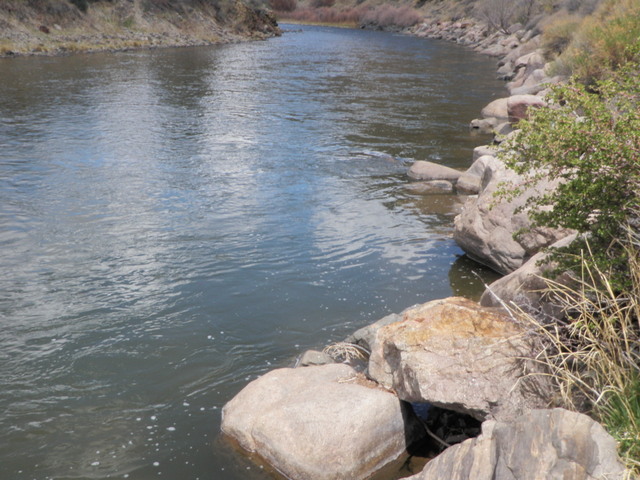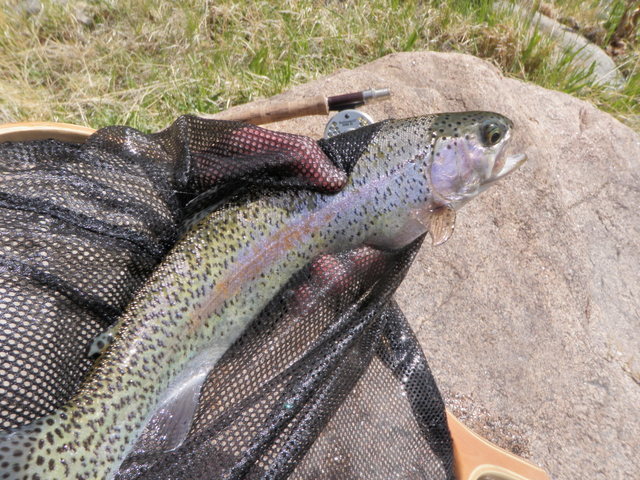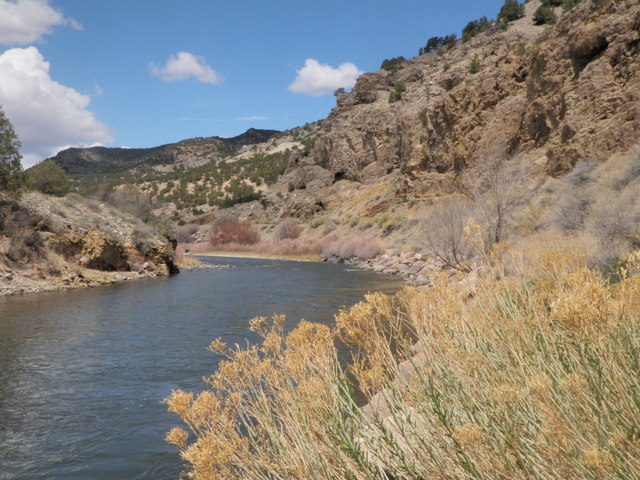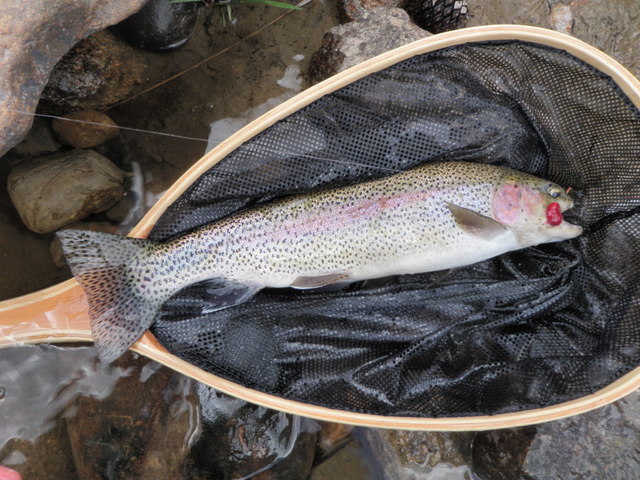Time: 10:30AM – 4:00PM
Location: Lunch Rock and downstream to nearly Wellsville Bridge
Fish Landed: 7
Arkansas River 05/10/2013 Photo Album
With the pre-snowmelt season winding down, I planned yet another trip to the Arkansas River in hopes of intersecting the caddis hatch. I hoped to travel on Thursday evening and set up my two person tent in one of the riverside campgrounds, but the precipitation and cold temperatures prevented this plan from becoming reality. Instead I got up early and managed to leave the house by 6:45 thus missing the rush hour traffic. I cruised through South Park on dry bare roads, but it was evident that the recent rain in Denver added more snow to the high country snowpack. The peaks above timberline were pure white and probably hold more snow on May 10 than they had over the entire winter season.
It was 45 degrees when I arrived at the pullout by lunch rock as I planned to experiment with the stretch of water between lunch rock and the Wellsville bridge. I visited this area in the fall and had some success but I was foiled in my attempt to fish the opposite bank by a thunderstorm that forced me back to the car. I pulled on my fleece and raincoat and strung my Sage four weight and headed down the shoulder of the road to a point where the top strand of barbed wire was removed from the fence thus enabling me to carefully climb over and descend to the river. I reached the point where the river split around a long narrow island and waded across the shallow wider channel closest to me. At this point I decided to walk to the downstream point of the island and explore the smaller braid.
The water was up a bit from what we encountered on Saturday and stained a light olive, but visibility for the fish was still adequate. Because of my success on Saturday with the dry/dropper rig and the continuing low flows I elected to go with the dry/dropper configuration and tied on a tan pool toy and below that knotted a beadhead bright green caddis pupa and a beadhead prince nymph. I thoroughly covered a nice deep pool at the bottom of the braid with no success and then moved to a nice run towards the top of the braid. It was here that I spotted a couple looks from trout that rose toward the surface and inspected the hopper but then returned to their position. This wasn’t a good sign. I continued a bit further and finally experienced a hook up with what felt like a decent fish, but it shed the hook after a thirty second connection.
When I reached the top of the island I encountered a very long deep pool so I climbed up on the rocks on the bank opposite the road and negotiated my way up along the pool. It was slow going as the bank was steep and comprised of loose gravel and I had to frequently climb and descend to get around the rabbitbush occupying the arid soil. After doing this for thirty or forty yards, I paused and spotted a nice rainbow very tight to the rocks along the shore. I dropped a few short casts above the fish, but apparently I startled it and could no longer spot its position. However, as I looked upstream, I noticed a rise in a small slick next to the bank where the current deflected from the rocks back toward the river. It was still quite sunny and before noon, so I was curious to observe what these fish might be interested in. I looked at the water more closely and as I did this spotted a couple small blue winged olives on the surface and then two or three fish magically appeared in the small area where I’d seen the previous rise. They were hovering a foot or so below the surface and finning up to snatch tiny morsels on fairly regular intervals.
I clipped off the pool toy and nymphs and tied on my trusty CDC BWO and lofted a cast toward the pod of fish. Unfortunately as the hatch began some clouds blocked the sun’s rays and the wind kicked up. This happened on Saturday as well and I’m curious to know how the BWO’s know to anticipate the cloudiness and wind. I continued to work out line and extended my casts by compensating for the wind with more power on the forward stroke and shooting further up above the fish. Eventually I got the fly to land in the middle of the small pool and as it drifted a foot or two a small whirlpool appeared where one of the trout sucked in the imitation. I set the hook and the rainbow did an immediate tail dance and then shot across the river a bit before it paused and I applied some side pressure. I was able to gain some ground before the rainbow sensed it was getting close to me and my waiting net at which point it bolted downstream and peeled off line at an alarming rate. Just when I thought I’d have to follow it downstream over the rocky shoreline, it stopped and I furiously reeled up line.
A couple more shorter runs ensued, but I finally managed to net the fish. Unfortunately I was in an awkward position and I couldn’t find a flat surface to photograph the silvery beauty so I snapped one photo while it rested in the net and followed that with a photo while I gripped it through the net. It was a thrilling first catch of the day. After I dried the CDC BWO and fluffed the wing I gazed back at the small pool and sure enough spotted a rise. Luck was on my side and the fish had resumed feeding, so I shot my fly higher up to the top of the pool as the two visible fish were above the position where I’d hooked my first victim. After numerous unproductive drifts I spotted a sip in the vicinity of my fly and raised the rod tip. Whoosh! Another rainbow shot toward the main current and put on an aerial display with several leaps above the surface. This fish put up an equally valiant battle compared to his brother, but eventually I landed and released the fine finned warrior. The second rainbow was probably fifteen inches in length and equally powerful.
Once I was ready to resume fishing I spotted a third remaining fish make a quick rise to snatch a BWO. I dried my fly and flicked a few casts to the area where the remaining fish was working, but after ten or so drifts, I never spotted the fish or another rise, so I tipped my hat and moved on. The sun was bright now and the air had warmed considerably so I removed my top layers and my backpack and sat on a large rock next to the river and ate my lunch. After lunch I resumed my up and down scramble between the river and the railroad tracks until I reached the head of the long pool. I didn’t spot anymore rises and propecting with the tiny BWO always seems futile, so I reverted to the dry/dropper method except I substituted a Chernobyl ant for the pool toy.
I continued with the caddis pupa but replaced the prince with a beadhead hares ear and worked the pockets tight to the bank. When I was opposite and slightly below a pair of fishermen on the opposite bank, I landed a 12 inch brown on the BHHE. I continued on covering quite a bit of water and picked up two more browns on the hares ear using the dry/dropper technique with three flies. It was pretty slow going, but at least I was catching the occasional fish to keep my interest up. Finally I reached lunch rock and proceeded upstream from there to a nice riffle stretch with perhaps three to four feet of depth over a rocky bottom. This type of water always produces on the Arkansas and I did manage to hook a fish that shot to the left toward the middle of the river and shook off the fly.
By three o’clock I reached another long slow moving pool and I was looking for faster water with riffles or pockets along the bank. Once again the sun disappeared and a breeze kicked up and I was about to skip the slow water and move up to the head of the pool and try some faster water. As I looked closely at the pool I spotted a decent trout hovering below the surface in front of a large submerged rock. I watched for a bit and I was excited to see the fish rise and sip something from the surface. There were some caddis tumbling on the surface, but then I began to see BWO’s again. I decided to convert back to the CDC BWO and as I worked on removing my flies and tying on a CDC BWO, I noticed some rises near another submerged rock eight feet further downstream.
Now the trick was how to present my tiny fly without drag and accurately to these fish. The wind was once again blowing upstream, and as I cast my fly across, the wind whipped it directly upstream. It was very difficult to see where the fly landed because of its tiny size and because the wind caught it and pushed it further upstream. I continued working to get my fly over the upper fish, and eventually as I lifted to make a cast I felt the weight of a fish. This fish turned out to be another rainbow and it put up a nice fight, but eventually I slid my net under a 14 inch fish. As I netted the fish I noticed a red round object in the corner of its mouth and thought the fish had taken an egg fly, but upon closer inspection I realized that the red growth was a tumor or abnormality of some sort.
Once I released the fish, the hatch waned and the sun appeared briefly. I worked my way upstream a bit to a nice deep run with a lot of swirly currents. Again I was seeing an occasional caddis tumbling on the surface, so I decided to replace the CDC BWO with an olive brown deer hair caddis. This was much more visible, and I was determined to catch a fish on a caddis dry fly. I began prospecting the seam and run with the caddis, and much to my surprise a brown rose and slurped in the caddis. It was smaller than the rainbows I’d cuaght, but it was still fun to catch a fish on a caddis dry fly. I continued prospecting with the caddis, and once again the sun disappeared and I observed some more BWO’s on the surface. The caddis was not attacting any more interest, and as my watch ticked past 4PM I decided to walk back to a crossing point and return to the car.
It was a slow cool day on the Arkansas River but I managed to land seven fish including three quite nice rainbows that put up strong fights. I have to admit I was somewhat discouraged by the low catch rate and the off colored water. Perhaps I need to rest the Arkansas and look for some action closer to Denver before the snow melt makes fishing difficult.




